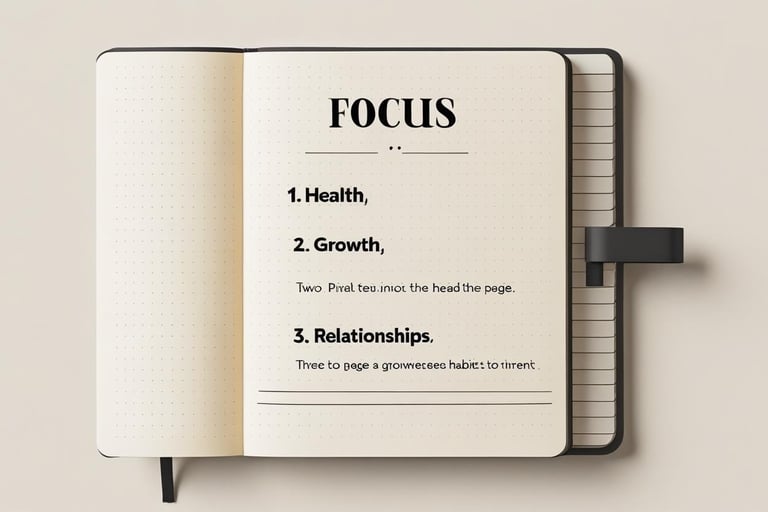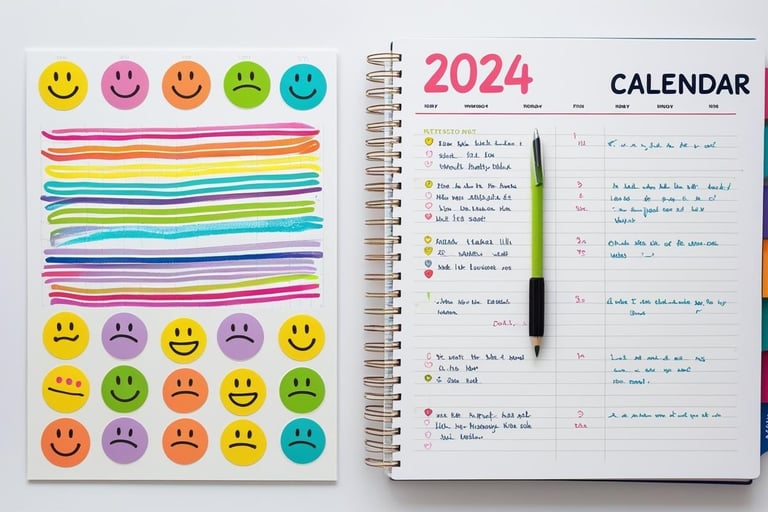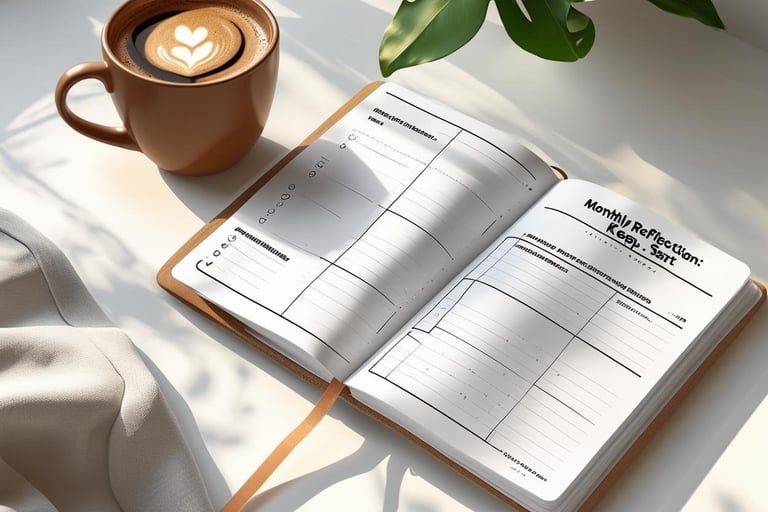How to Create a Personal Growth Plan That Actually Works
FEATUREDHEALTH & LIFESTYLE


Learn how to build a personal growth plan that works — with clarity, purpose, and real habits. Start evolving with intention, not overwhelm.
Introduction
What if this year, your self-improvement wasn’t just a wish, but a plan?
We all crave growth — to become more confident, focused, fulfilled.
But most people stop at vague goals like “read more” or “get fit.” Then life takes over, motivation fades, and we’re left with guilt instead of progress.
The truth? Personal growth isn’t a mystery. It’s a system.
And when built right, a personal growth plan gives you:
Direction when you're lost
Confidence when you're doubting
Momentum when you're stuck
In this blog, we’ll walk you through how to build a practical, science-backed, and emotionally aligned personal growth plan — one that’s not just inspirational but doable. Because real growth isn’t about doing more.
It’s about becoming more of who you already are — with clarity and care.
1. Start with Your “Why” — Not Just What You Want


You want to work out consistently. So you set a goal: “Go to the gym 4 times a week.”
But within two weeks, you’re skipping sessions. — Why?
Because motivation fades — but meaning lasts.
"Find Your Emotional Anchor"
Instead of just writing “exercise,” ask:
Why do I want this?
What would it give me?
How will I feel if I succeed?
Maybe your deeper reason is:
“I want energy to play with my kids.”
“I want to feel strong after years of self-doubt.”
“I want to live longer than my parents did.”
That’s your emotional anchor — your why. It fuels action when discipline runs low. Science Insight:
According to Stanford psychologist Kelly McGonigal, goals tied to identity and values are 25% more likely to be sustained than those based on outcome alone.
Takeaways:
Don’t just ask what you want. Ask why it matters.
Link your growth plan to emotion, not ego
2. Choose 3 Growth Areas — Not 30 Goals


Here’s the biggest mistake most people make: They try to fix everything at once.
Wake up early. Meditate. Eat clean. Start a podcast. Learn Spanish. Build abs. Read 30 books. It’s inspiring and overwhelming.
The Rule of 3:
Pick just three core areas for your growth plan. For example:
Health (energy, sleep, movement)
Focus (attention, deep work, reduced screen time)
Communication (public speaking, writing, difficult conversations)
That’s it. This simplifies your life and sharpens your results.
Real-world tip:
Pick one habit per area. Track it weekly. Let success compound.
Case example (India):
A Mumbai-based product manager chose these:
Health: 7,000 steps/day
Focus: 1 hour of deep work each morning
Communication: 1 voice note/week to a friend
She didn’t overhaul her life — but her energy, clarity, and relationships grew exponentially in 90 days.
Takeaways:
Depth over distraction is the new self-care
3 areas, 3 micro habits = 10x results
3. Build a Simple Tracking System (That You’ll Actually Use)


Here’s the secret to real change: It’s not about perfection — it’s about progress you can see.
That’s where tracking comes in.
But we’re not talking about overwhelming spreadsheets or 20-step bullet journal rituals.
We’re talking about a low-effort, high-impact system that fits your lifestyle.
Choose Your Method:
Pick one method you’ll actually stick to:
Calendar Habit Tracker: Mark an X for each day you complete your habit
App-Based Tools: Try Habitica, Notion templates, or Google Sheets
Weekly Reflection Log: Write 3–5 lines every Sunday on wins, misses, and next steps
Keep It Visual + Emotional
Instead of just marking “done,” note:
How did I feel?
What helped me succeed?
What tripped me up?
Science Insight:
According to James Clear (Atomic Habits), visual progress boosts habit completion by up to 40%, especially when paired with positive reinforcement.
Takeaways:
Simplicity beats complexity
Progress feels better when you can see it building
4. Expect Resistance — and Plan for It in Advance


Growth isn’t linear. You will have off days. You’ll want to quit. That’s not failure — it’s human.
What separates achievers from wishful thinkers is resilience planning.
The “If-Then” Strategy:
Before life derails you, write:
“If I miss a workout, then I’ll take a 10-minute walk at lunch.”
“If I scroll for too long, then I’ll pause and journal one line.”
“If I feel demotivated, then I’ll re-read my WHY list.”
This is called implementation intention — and it’s proven to increase habit follow-through by up to 91% (Gollwitzer et al., 1999).
Bonus: Create a Growth Mantra
When motivation fades, repeat a personal growth mantra like:
“I don’t have to be perfect, just present.”
“Small steps, daily.”
“This version of me is worth showing up for.”
Takeaways:
Resistance is part of the process — not a sign to stop
Plan your rebound before the fall
5. Reflect, Revise, and Reinvent Every 30 Days


Most growth plans fail not because they’re bad — but because they’re static.
You grow. Your goals shift. Life throws curveballs. So your plan needs rhythm, not rigidity.
🧭 The 30-Day Reset Ritual
Set a recurring calendar reminder every 30 days to ask yourself:
What went well?
What felt forced?
What habit made the biggest difference?
What needs to be adjusted?
You can do this in a journal, a Notion doc, or even over coffee with a trusted friend.
✍️ Try the "Keep–Drop–Start" Exercise:
Keep: What’s working and should stay
Drop: What no longer aligns
Start: What new experiment feels exciting or necessary
Real-world tip:
Use this time to celebrate small wins. That one tough conversation, that one day you chose a walk over a scroll — they matter.
Takeaways:
Growth is seasonal — reflect often, revise with kindness
You’re not behind. You’re becoming.
Conclusion: Growth Is Not a Checklist
— It’s a Conversation With Your Future Self
Here’s what most self-help blogs miss:
Real growth is messy. It’s nonlinear. It’s deeply human.
You’ll have weeks of momentum and days of inertia.
You’ll set goals, then outgrow them.
You’ll forget your why — and then remember it during a walk or a quiet conversation.
That’s okay.
The goal isn’t perfection. It’s presence.
And a personal growth plan isn’t about controlling your life. It’s about meeting yourself on purpose — over and over again.
Call to Action
This week, choose just one area of growth and define why it matters to you
Use the “Keep–Drop–Start” model to create a 30-day experiment
Share this blog with a friend who’s ready to grow — and subscribe to the FireFlower Network for bold, practical guides to becoming who you’re meant to be
Click here to Read about : 10 Daily Habits Backed by Science for Better Mental Health
